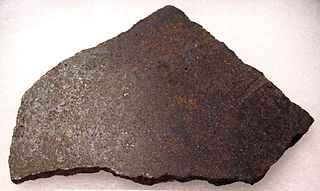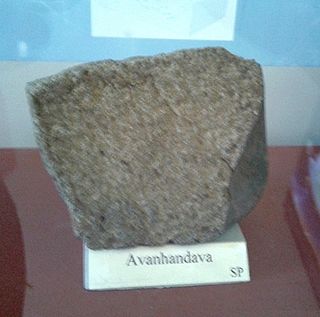| Ambapur Nagla | |
|---|---|
| Type | Chondrite |
| Class | Ordinary chondrite |
| Group | H5 |
| Country | India |
| Region | Uttar Pradesh |
| Coordinates | 27°40′N78°15′E / 27.667°N 78.250°E Coordinates: 27°40′N78°15′E / 27.667°N 78.250°E [1] |
| Observed fall | Yes |
| Fall date | May 27, 1895 |
| TKW | 6.4 kg |
Ambapur Nagla is an H chondrite meteorite that fell to earth on May 27, 1895, in Uttar Pradesh, India.

The H type ordinary chondrites are the most common type of meteorite, accounting for approximately 40% of all those catalogued, 46% of the ordinary chondrites, and 44% of the chondrites. The ordinary chondrites are thought to have originated from three parent asteroids, whose fragments make up the H chondrite, L chondrite and LL chondrite groups respectively.

A meteorite is a solid piece of debris from an object, such as a comet, asteroid, or meteoroid, that originates in outer space and survives its passage through the atmosphere to reach the surface of a planet or moon. When the object enters the atmosphere, various factors such as friction, pressure, and chemical interactions with the atmospheric gases cause it to heat up and radiate energy. It then becomes a meteor and forms a fireball, also known as a shooting star or falling star; astronomers call the brightest examples "bolides". Meteorites vary greatly in size. For geologists, a bolide is a meteorite large enough to create an impact crater.

Uttar Pradesh is a state in northern India. With roughly 200 million inhabitants, it is the most populous state in India as well as the most populous country subdivision in the world. It was created on 1 April 1937 as the United Provinces of Agra and Oudh during British rule, and was renamed Uttar Pradesh in 1950. The state is divided into 18 divisions and 75 districts with the capital being Lucknow. The main ethnic group is the Hindavi people, forming the demographic plurality. On 9 November 2000, a new state, Uttarakhand, was carved out from the state's Himalayan hill region. The two major rivers of the state, the Ganga and Yamuna, join at Allahabad (Prayagraj) and then flow as the Ganga further east. Hindi is the most widely spoken language and is also the official language of the state, along with Urdu.








